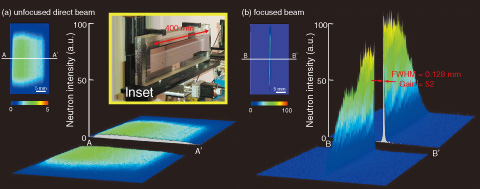
Fig.13-7 Neutron focusing images obtained by large-scale elliptical supermirror ((a): unfocused direct beam; (b): focused beam)
Slow neutrons, which exhibit quantum mechanical wave properties, are used to investigate crystal and molecular structures and dynamics in solid-state physics, polymer and biological sciences, and so on.
Neutron focusing devices play the important roles of focusing neutrons on samples and increasing the available neutron intensities or improving the experimental resolutions in various experiments such as small-sample diffraction and small-angle scattering. Therefore, high-performance focusing mirrors have been aggressively developed to accelerate the exploration of new scientific phenomena at neutron experimental facilities worldwide, such as J-PARC.
We successfully developed focusing supermirrors with a large critical angle, high reflectivity, and low diffuse scattering by using ion beam sputtering (IBS). A precise surface figure was obtained on the focusing mirror by using the numerically controlled local wet etching (NC-LWE) on the mirror substrate. The NC-LWE technique enables an aspherical shape to be figured deterministically with sub-micrometer form accuracy because it uses a noncontact chemical removal process that is insensitive to external disturbances such as vibration and/or thermal deformation.
We designed and fabricated one-dimensional neutron focusing with a large beam divergence by a 400-mm-long elliptical supermirror. A NiC/Ti supermirror with 1200 layers was deposited on the substrate using the IBS instrument. We successfully obtained a figure error of 0.43 μm peak-to-valley with a surface roughness of less than 0.2 nm root mean square. The neutron reflectivity was measured using the BL17 SHARAKU instrument at J-PARC/MLF. The reflectivity of the m = 4 supermirror was ≅0.6.
The focusing performance of the fabricated elliptical supermirror was evaluated at BL10 NOBORU. The wavelength of the neutron beam was varied from 3.5 to 10 Å. The upstream width of the slit in this experiment was 0.10 mm.
Fig.13-7 shows neutron profiles of the unfocused direct beam and the focused beam. The full width at half-maximum (FWHM) of the focused beam was 0.128 mm, and a focusing gain of 52 in terms of the peak intensity was achieved compared with the unfocused direct beam. Note that the tail of the focused beam is no larger than that of the unfocused beam profile, which suggests that the focusing mirror produces little diffuse scattering.